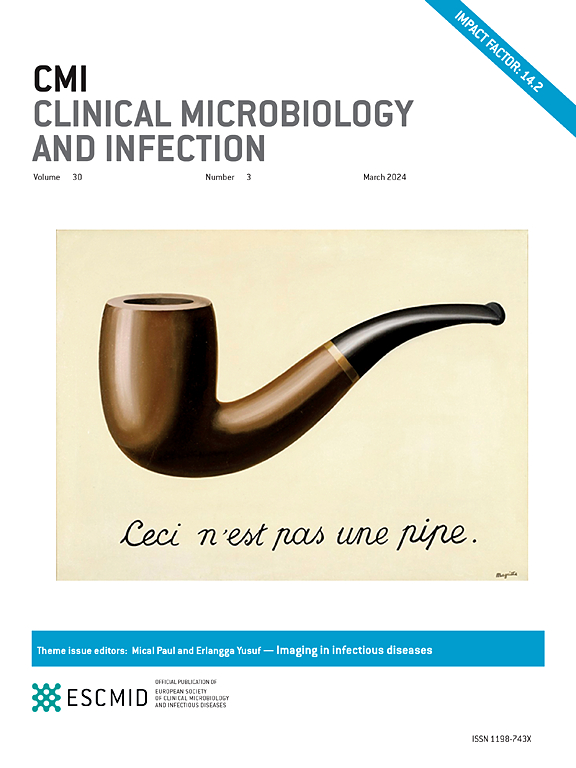Unexpected natural cefiderocol resistance in Stenotrophomonas maltophilia associated to the genogroup 4 genetic background
IF 8.5
1区 医学
Q1 INFECTIOUS DISEASES
引用次数: 0
Abstract
Objectives
Stenotrophomonas maltophilia (Sm) is responsible for infections in immunocompromised and hospitalized patients. Its genomic diversity has led to the description of a large complex including numerous genogroups. Regarding acquired resistances, cefiderocol (CeFiDeroCol, CFDC) is a promising therapeutic option. We aimed to evaluate the CFDC susceptibility of a large panel of Sm strains and explored the genetic support and background of resistance.
Methods
We prospectively collected 154 non-duplicated clinical and environmental strains from five university hospitals between January 2023 and April 2024. All the strains were whole-genome sequenced and their genetic background studied using multi-locus sequence typing , core genome multi-locus sequence typing, and genogroup determination. CFDC susceptibility was tested using a two-step approach with a marketed product (screening step) and the broth microdilution method (confirmation step). Strains exhibiting an MIC >1 mg/L were considered as non-susceptible (ns). We used a national 2013 strain collection to confirm the resistance in a particular genogroup. The genetic support of CFDC non-susceptibility was studied according to a collection of previously selected CFDC mutants.
Results
Six of 154 Sm strains (4%) were non-susceptible to CFDC, including one environmental strain and five clinical strains. None of the patients was exposed to CFDC. The strains belonged to four different sequence type (ST) (ST87, n = 2; ST39, n = 2; ST18, n = 1; and unknown, n = 1) but to the same genogroup (genogroup 4). All seven 2013 genogroup 4 strains were also non-susceptible to CFDC. None of the previously published mutations/deletions were identified, but common non-synonymous mutations were found in tonB and tolQ; a common polymorphism was identified in the promoter region of smet.
Discussion
The natural intrinsic non-susceptibility of the genogroup 4 could hamper the contribution of CFDC for the empiric treatment of Sm infections.
嗜麦芽寡养单胞菌意外的天然头孢地罗耐药性与基因组4遗传背景有关。
目的:嗜麦芽窄养单胞菌(Sm)是免疫功能低下和住院患者感染的原因。它的基因组多样性导致了一个包括许多基因群的大型复合体的描述。对于获得性耐药,头孢地罗(FDC)是一种很有前景的治疗选择。我们的目的是评估大量Sm菌株对FDC的敏感性,并探索抗性的遗传支持和背景。方法前瞻性收集2023年1月至2024年4月5所大学附属医院154株非重复临床及环境菌株。对所有菌株进行全基因组测序,并采用多位点序列分型(MLST)、核心基因组分型(MLST)和基因群测定对其遗传背景进行研究。FDC药敏试验采用两步方法,采用市售产品(筛选步骤)和肉汤微量稀释法(确认步骤)。MIC值为1 mg/L的菌株被认为是不敏感的(ns)。我们使用2013年全国菌株收集来确认特定基因组的耐药性。根据先前选择的FDC突变体,研究了FDC不易感性的遗传支持。结果154株Sm菌株中6株(4%)对FDC不敏感(ns-FDC),其中1株为环境菌株,5株为临床菌株。没有患者暴露于FDC。菌株属于4种不同的ST (ST87, n=2;ST39, n= 2;ST18, n=1,未知,n=1),但属于同一基因组(基因组4)。7株2013年4基因组菌株均为ns-FDC。之前发表的突变/缺失均未被鉴定,但在tonB和tolQ中发现了常见的非同义突变;在smet的启动子区发现了一个共同的多态性。结论:基因组4的自然固有非易感性可能阻碍了FDC对Sm感染经经验治疗的贡献。
本文章由计算机程序翻译,如有差异,请以英文原文为准。
求助全文
约1分钟内获得全文
求助全文
来源期刊
CiteScore
25.30
自引率
2.10%
发文量
441
审稿时长
2-4 weeks
期刊介绍:
Clinical Microbiology and Infection (CMI) is a monthly journal published by the European Society of Clinical Microbiology and Infectious Diseases. It focuses on peer-reviewed papers covering basic and applied research in microbiology, infectious diseases, virology, parasitology, immunology, and epidemiology as they relate to therapy and diagnostics.

 求助内容:
求助内容: 应助结果提醒方式:
应助结果提醒方式:


